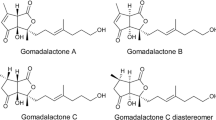Zusammenfassung
Wenn das Weibchen des Seidenschmetterlings Bombyx mori bei der Balz seinen Sexuallockstoff, das Bombykol, ausstößt, dann nimmt das Männchen ihn noch in der unglaublichen Verdünnung von 1000 Molekülen pro Kubikzentimeter Luft wahr. Das ist so verdünnt, als hätte man eine Maß Bier über dem Luftraum von Deutschland verteilt! Gleichzeitig fliegt das Männchen auf die Quelle des Geruchs zu, egal welche Hindernisse im Wege liegen mögen, egal ob es den Duft schon öfter gerochen hat oder das erste Mal. Und wenn der unwiderstehliche Duft aus einer von Menschen gemachten Falle strömt, dann stürzt es sich hinein.
Access this chapter
Tax calculation will be finalised at checkout
Purchases are for personal use only
Preview
Unable to display preview. Download preview PDF.
Similar content being viewed by others
Literatur
Bird S, Gower DB (1981) The validation and use of a radioimmunoassay for 5 α-androst-16-en-3-one in human axillary collections. J Steroid Biochem 14:213–219
Brooksbank BWL, Brown R, Gustafsson J-A (1974) The detection of 5-Androst-16-en-3α-ol in human male axillary sweat. Experientia 30:864–865
Cain WS (1977) Physical and cognitve limitations on olfactory processing in human beings. In: Müller-Schwarze D, Mozell MM (eds) Chemical signals in vertebrates. Plenum Press, New York, pp 287–302
Claus R, Alsing W (1976) Occurence of 5 α-androst-16-en-3-one, a Boar pheromone, in man and its relationship to testosterone. J Endocrinol 68:483–484
Claus R, Hoppen HO (1979) The boar-pheromone steroid identified in vegetables. Experientia 35:1674
Claus R, Hoppen HO, Karg H (1981) The secret of truffles: A steroidal pheromone? Experientia 37:1178–1179
Cleveland WW, Savard K (1964) Studies of excretion of androst-16-en-3α-ol. J Clin Endocrinol 24:983–987
Eibl-Eibesfeldt I (1970) Liebe und Haß. Piper, München, S 193
Engen T (1982) The perception of odors. Academic Press, New York, p 97
Graham CA, McGrew WC (1980) Menstrual synchrony in female undergraduates living on a coeductional campus. Psychoneuroendocrinology 5:245–252
Gower DB (1972) 16-unsaturated C19 steroids. J Steroid Biochem 3:45–103
Hall ET (1966) The hidden dimension. New York, Doubleday
Kaplan JN, Russell M (1974) Olfactory recognition in the infant squirrel monkey. Developm Psychobiol 7:15–19
Kaplan JN (1978) Olfactory recognition of mothers by infant squirrel monkeys. In: Chivers DJ, Herbert J (eds) Recent advances in primatol-ogy, Vol 1. Academic Press, London, p 103–105
Kindermann W, Altenkirch H (1982) Lösungsmittelmißbrauch und Heroinabhängigkeit. DHS-Informationsdienst 35/3/4:22–28
Kirk-Smith M (1980) Unconscious odour conditioning in human subjects. In: van der Starre H (ed) Olfaction and taste VII. IRL Press, London, p 438
Kirk-Smith M, Booth DA (1980) Effect of androstenone on choice of location in other’s presence. In: van der Starre H (ed) Olfaction and taste VII. IRL Press, London, pp 397–400
Koelega HS, Köster EP (1974) Some experiments on sex differences in odor perception. In: Cain WS (ed) Odors; evaluation, utilization and control. NY Acad Sci 237:234–246
Lee van der S, Boot LM (1956) Spontaneous pseudopregnancy in mice II. Acta Physiol Pharmacol Neerl 5:213–215
Le Magnen J (1952) Les phénomenes olfacto-sexuels chez l’homme. Arch Sci Physiol 6:125–160
Leyhausen P (1973) Addictive behavior in free ranging animals. Bayer-Symposium IV, Psychic Dependence, pp 58-64
McClintock MK (1971) Menstrual synchrony and suppression. Nature 229:244–245
McFarlane A (1975) Olfaction in the development of social preferences in the human neonate. In: Porter R, O’Connor M (eds) The human neonate in parent-infant interaction. Ciba Foundation, vol 33, Amsterdam, pp 103–117
Palen GF, Goddard GV (1966) Catnip and oestrous behaviour in cats. Anim Behav 14:372–377
Popper KR, Eccles JC (1977) Das Ich und sein Gehirn. Piper, München
Russell MJ, Switz GM, Thompson K (1980) Olfactory influences on the human menstrual cycle. Pharmacol Biochem Behav 10:390
Schaal B, Montagner H, Hertling E, Bolzoni D, Moyse A, Quichon A (1980) Les stimulations olfactives dans les relations entre l’enfant et la mère. Repr Nutr Develop 20:843–858
Schleidt M (in Vorbereitung) Die Rolle von Geruch im Sozialverhalten des Menschen
Schleidt M, Hold B, Attili G (1981) A cross-cultural study on the attitude towards personal odors. J Chem Ecology 7:19–31
Schleidt M, Hold B (1982) Human odour and identity. In: Breipohl W (ed) Olfaction and endocrine regulation. IRL Press, London, pp 181–194
Schleidt M, Hold B (1982) Human axillary odour: Biological and cultural variables. In: Steiner JE (ed) Determination of behavior by chemical stimuli. IRL Press, London, pp 91–104
Stanjek K (1980) Die Entwicklung des menschlichen Besitzverhaltens. Max-Planck-Institut für Bildungsforschung Berlin. Materialien aus der Bildungsforschung Nr. 16
Steinke M (1972) Über das Schnüffeln, einer Sonderform jugendlichen Rauschmittelmißbrauchs. Öffentl Gesundheitsw 34:703–707
Todd NB (1963) The catnip response. Ph D Thesis, Harvard Univ Press, Cambridge, Mass
Vandenbergh JG (1967) Effect of the presence of a male on the sexual maturation of female mice. Endocrinology 81:345–349
Vandenbergh JG, Whitsett JM, Lombardi JR (1975) Partial isolation of a pheromone accelerating puberty in female mice. J Repr Fert 43:515–523
Winnicott D (1953) Transitional objects and transitional phenomena. Int J Psychoanal 24:89–97
Yfantis C (1980) Geruchserkennen zwischen Mutter und Kind. Diplomarbeit, Universität München334-345
Rights and permissions
Copyright information
© 1985 Springer-Verlag Berlin Heidelberg
About this chapter
Cite this chapter
Schleidt, M. (1985). Beziehungen zwischen Riechen, Pheromonen und Abhängigkeit. In: Biologie der Sucht. Suchtproblematik. Springer, Berlin, Heidelberg. https://doi.org/10.1007/978-3-642-82542-2_24
Download citation
DOI: https://doi.org/10.1007/978-3-642-82542-2_24
Publisher Name: Springer, Berlin, Heidelberg
Print ISBN: 978-3-540-15560-7
Online ISBN: 978-3-642-82542-2
eBook Packages: Springer Book Archive




